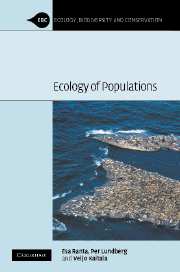Book contents
- Frontmatter
- Contents
- Preface
- 1 Introduction
- 2 Population renewal
- 3 Population dynamics in space – the first step
- 4 Synchronicity
- 5 Order–disorder in space and time
- 6 Structured populations
- 7 Biodiversity and community structure
- 8 Habitat loss
- 9 Population harvesting and management
- 10 Resource matching
- 11 Spatial games
- 12 Evolutionary population dynamics
- 13 Epilogue
- References
- Index
2 - Population renewal
Published online by Cambridge University Press: 02 December 2009
- Frontmatter
- Contents
- Preface
- 1 Introduction
- 2 Population renewal
- 3 Population dynamics in space – the first step
- 4 Synchronicity
- 5 Order–disorder in space and time
- 6 Structured populations
- 7 Biodiversity and community structure
- 8 Habitat loss
- 9 Population harvesting and management
- 10 Resource matching
- 11 Spatial games
- 12 Evolutionary population dynamics
- 13 Epilogue
- References
- Index
Summary
Population renewal is about how births and deaths of individuals are translated into population level dynamics. Here, we are reviewing some basic concepts and models of population renewal, disregarding both spatial processes (immigration and emigration) as well as interactions with other populations. Those extensions will be addressed in subsequent chapters. We are also briefly reviewing some statistical building blocks necessary for understanding population dynamics as a stochastic process and not only a deterministic route to persistence or extinction. This includes primarily the time series approach to population dynamics. We conclude this chapter by highlighting some very important and disturbing problems when confronting models with data (and the reverse), especially when trying to disentangle the demographic skeleton from “noise.”
There is really nothing more to population ecology than births and deaths. If the number of individuals born exceeds the number that dies, the population size increases; should deaths exceed births, the population size decreases. If that simple, how is it so difficult to predict the population size in the future, and to determine what limits – or even regulates – the distribution and abundance of organisms in natural systems? We could argue that it is because the models we inevitably need to perform the above exercises are not good enough. One could also say that the task is difficult because it is not so easy to measure things accurately in nature. It is even problematic to determine what a population really is.
- Type
- Chapter
- Information
- Ecology of Populations , pp. 9 - 38Publisher: Cambridge University PressPrint publication year: 2005
- 1
- Cited by



